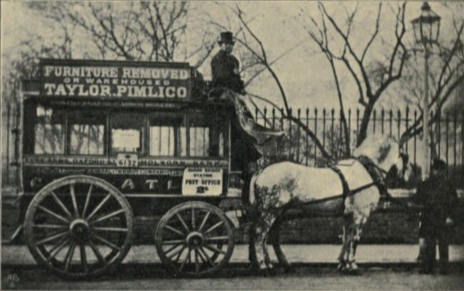3 Types of Victorian Transportation
Getting Around in 19th Century England
There are lots of different types of transportation in Victorian London. Here are three you may not know about…
Omnibus
In my most recent novel, The Bride of Blackfriars Lane, I featured an omnibus, which is a precursor to the trolley, first appearing in 1829. So, think of these as large horse-drawn carriages that traveled along a set route (like a bus route), picking up and dropping off passengers.
An omnibus was an enclosed vehicle with four windows and was toted about by one or two horses. Passengers sat on benches lining each side, entering via a door at the back, or they could climb up to sit on exposed seats up top. The driver rode at the front of the carriage with a conductor assisting and taking fares from passengers at the rear.
This form of transportation was really popular amongst the middle class. Those with less funding couldn’t afford the fare and the upper classes either hired a hackney or owned their own carriage.
Personally, I would rather walk, though, than snag a ticket for one of these bad boys. Often passengers were crammed in shoulder to shoulder, and this is before showers, mind you, so the stink would be, well, stinky.
Penny Farthing
Now another form of transportation that hit in the latter part of the century is the quintessential image one gets when thinking of a bicycle. You know, the tall bike with a huge front wheel and a tiny rear one? That’s a penny farthing.
Surprisingly these awkward looking bikes were relatively comfortable to ride. The large wheel in front provides pretty good shock absorption—which is important on London’s rutted roads. It was popular in the 1870s and 80s, then quickly went out of fashion when more modern bicycles appeared, much like the ones we ride today.
The name penny farthing however begs the question, what in the world does it mean? Well, it comes from coins, actually. A penny, believe it or not, was a much larger coin than a farthing, hence the large wheel being called a penny and the rear a farthing. During the time they were popular, though, they were simply called bicycles. To avoid confusion when the newer, sleeker models came out, the name was changed to hi-wheels and/or what we know as the penny farthing.
Funicular
And then last but not least let’s talk about cliff railways. I’m not a huge fan of heights, so this sort of transportation makes the hair on my neck stand out.
Not every city or town is as flat as London, so what to do when you have a huge cliff separating your high town from your low town? Why, build a vertical railroad, of course, which were sometimes called funiculars—that’s a fun name!
This sort of railway has two cars running on parallel tracks. One car ascends while the other car descends. Each car caried a tank of water underneath because it was driven by a water balance system. These two cars are attached to each other by hauling cables at the top and bottom of the tracks. When these cars are docked, the full water tanks are in balance and ready for loading (holding 700 gallons). Once passengers are loaded, the lower driver discharges water until the top car is heavier. Then the top car simply rolls down the rails which pulls the bottom car upwards. Then the process begins all over again.
But the biggest question is that fun name, right? Funicular comes from the Latin word Funiculus, which means rope…and that’s what the cables used to be made of, hence the name.
All my books feature various types of transportation, and for a rollicking good adventure on the streets of Victorian London, I suggest The Thief of Blackfrairs Lane and The Bride of Blackfriars Lane, both available at your favorite bookseller.


